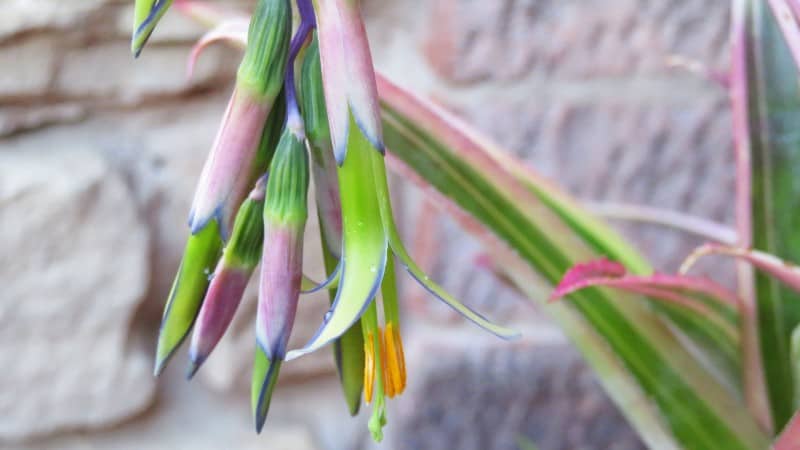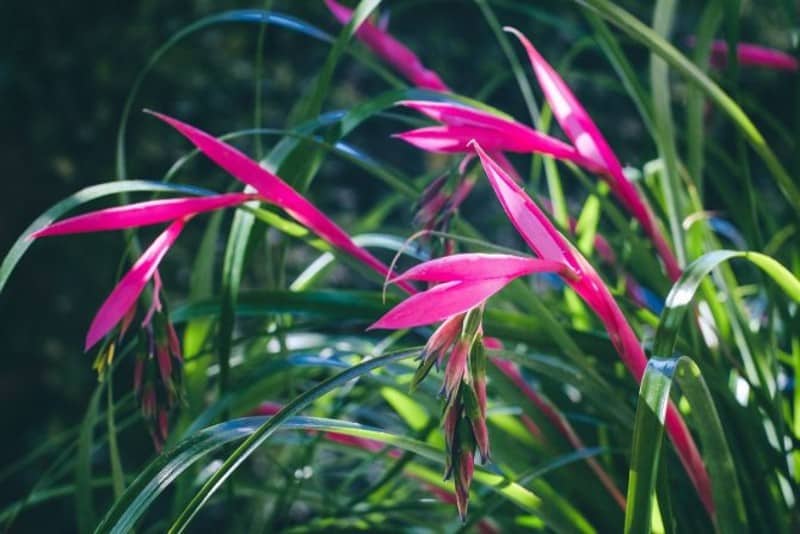No products in the cart.
Table of Contents
Want to have another tropical plant in your botanical garden? Well, this Queen’s Tears plant is the perfect indoor plant for you! Billbergia nutans bromeliad is a beautiful ornamental plant that has long-lasting flowers.
This shallow-rooting, the leathery-leafed plant can produce long stems with pink blooms. The flowers have elongated yellow stamens, and the entire bloom has a rainbow appearance. With great care for your Friendship plant, it will result in beautiful colors!
These plants are naturally aggressive growers with little to no specific light requirements and are easy to take care of.
Did you know that this beauty is called the Friendship plant due to its splitting and sharing nature? It can be split multiple times a year, consistently producing bright colors loved by all in their homes. Although this plant has an average lifespan of three years, it is easy to share with others for company!
I know this gorgeous one had already captured your attention. And don’t worry because we will teach you all the essential tips for the Queen’s Tears Billbergia Windii plant care! Read more below to find out more!
Queen’s Tears – Billbergia Windii Plant Care Basics

Before anything else, here’s a table form about all of the essential information you want to know about how this plant grows.

Already have a hint of what this beauty is like? Then what are we waiting for? Keep reading to know the essential tips about the Bromeliad Billbergia!!
Best Potting Mix
Queen’s Tears is a beautiful plant that looks wonderful in your home. When grown indoors, this epiphytic plant requires an orchid potting soil with one part gardening soil to two parts perlite. This can be simulated by using equal parts of gardening soil and tree bark. The pH level of the soil can also be slightly acidic soil.
Important note: If you are using a clay pot, make sure to add some rocks or pieces of broken pots to the bottom of the pot to improve drainage.
Light intensity

The plant does best in bright light but will tolerate partial shade. In fact, if the plant is getting too much sun, it may begin to lose its leaves. In the spring and early summer, move the plant to a spot to receive the morning sun.
In the late summer and fall, move it to an area where it will get dappled light or afternoon sun. Remember to not place the plant in direct sunlight if you treat them as an outdoor plant.
Water Frequency
Queen’s Tear’s bromeliads are relatively drought-tolerant, so water them frequently during the summer, just enough to keep the soil moist but never drenched. Like most bromeliads, you can also fill upward-facing cups with water. Water sparingly during winter, early spring, and autumn – just enough to keep the soil from becoming bone dry.
Important note: Use room-temperature rainwater or distilled water because this rainforest native is sensitive to chlorine and fluoride added to some tap water.
Ideal Temperature

This plant is particular about the temperature it prefers to be in. Your plant will require varying temperatures depending on the season to stay healthy. During the summer, temperatures range from 65 to 80 degrees Fahrenheit (18 to 27 degrees Celsius), with slightly colder temperatures of 60 to 75 degrees Fahrenheit (15.5 to 23.8 degrees Celsius).
Throughout the rest of the year, the temperature will be between 60.8 and 75.2 degrees Fahrenheit (16 and 24 degrees Celsius).
Important note: You can provide the correct temperature range for your Queen’s tears by using a plant thermometer. This will help you keep track of the temperatures of most plants and make sure they are within the ideal range.
Humidity Requirement
These tropical plants need plenty of humidity to thrive. In the summer months, you’ll need to mist the leaves and flowers every day to keep them healthy. Make sure the relative humidity is at least 40-50%.
If your home is arid in winter, use a cool-mist room humidifier. You should also make sure to mist the leaves and flowers every day, even when it’s not summertime.
Important note: Brown tips on the leaves are caused by dry air if growing indoors- if you have low humidity in your home year-round, they’ll be more likely to get brown leaf tips.
Fertilizing

Bromeliads need feeding every two weeks in spring and summer with a balanced, water-soluble fertilizer diluted to half strength. In fall and winter, provide once a month. You can add a teaspoon of Epsom salts to the water of stubborn plants in early March for on-time blooms.
Important note: Too much fertilizer may cause the leaves to turn green instead of having colorful variegation. And also, diluted or not, fertilizer should never be placed in that center “cup!” It’s because the salt could burn the leaves.
Propagation
Ready to propagate your mature plant? It is good to know that this kind of Bromeliad family is easy to propagate! Here’s how to reproduce Queen’s tears.
Once flowering has occurred, new shoots may be uprooted and broken off from the main plant. These can be transferred to their own pot, taking root over weeks. For best results, the offshoot should be at least one-third the height of the parent plant.
Place the plant in bright light throughout most of the year, but move it into light shade during the summer. Then, after a couple of weeks, your Queen’s tears Billbergia nutans will thrive beautifully.
Growth Zone
These plants can grow and thrive in USDA Zone 11.
Potting and Pruning
Billbergia can be grown in tiny pots with slightly acidic soil that drains well. Alternatively, the plants can be put on a driftwood-like substrate. Depending on the species, Billbergia can grow 8 inches tall or 36 inches tall. In a modest 4-inch pot, smaller species will thrive.
Larger species can grow up to 6 inches in a pot.
Before flowering, this plant should be re-potted, using a larger pot each time until the pot is 5 inches (12.5 cm) across.
Queen’s Tears – Billbergia Windii Varieties and Similar Plants
A fun fact about this beauty is that Billbergia comes in various colors and shapes! Don’t worry because we’ve provided a list of Billbergia varieties that would make a great addition to any bromeliad collection! Here are some of them:
- Billbergia ‘Casa Blanca’
This flower is recommended for novice bromeliad growers. The plant’s leaves are a gorgeous shade of green with white mottling. The leaves form a tube-shaped rosette when they stand straight up.
With pink bracts and turquoise blooms, the inflorescence is also erect.
- Billbergia pyramidalis
It’s a great landscape plant. It can withstand extreme cold and requires very little maintenance. The plant forms clusters easily and thrives in both shade and full light. The hue of the leaves will be affected by the amount of sunshine.
It also blooms with large, rounded pink and purple flowers in the summer. This bouquet will last about a month.
- Billbergia zebrina
This is a one-of-a-kind plant. The silvery horizontal banding on the foliage gives it its name. The plant produces a big pendant bloom with pink bracts and brilliant green petals that are tightly recurved.
“Queen’s tears” is another frequent name for this plant.
Queen’s Tears – Billbergia Windii Diseases & Pests
Pests
Aphids. Keep an eye out for minor green bugs on your Queen’s Tears – Billbergia Windii Plant. They can be very destructive and suck the sap from tender new growth, stunting or killing it. Their presence is also a sign that you have aphid-attracting ants nearby because they farm these little buggers.
If you see signs of aphids on your Queen’s Tears, wash them off with water (remember to be gentle!), or if the infestation is bad enough, use an insecticidal soap spray.
Spider Mites. Often these tiny spider-like pests spin webs around stems and leaves. They suck the sap from your Queen’s Tears – Billbergia Windii Plant, causing leaves to curl up and turn yellow or even brown if their numbers are significant enough. Treat spider mites by blasting them with water (remember gentle!), dabbing them off individually with a cotton swab soaked in rubbing alcohol, or spraying an insecticidal soap spray.
Snails and Slugs. These garden pests can do a number on your Queen’s Tears – Billbergia Windii Plant if they’re not kept in check. They feed at night, so you’ll want to hunt them down then with a flashlight (or slug bait). If the infestation is bad enough, use an organic, iron phosphate-based snail and slug bait.
Diseases
- The first disease is called root rot. This happens when the plant’s roots become too wet and start to rot. The best way to prevent this is to ensure that the soil is well-drained. You can do this by adding sand or perlite to the soil.
- Another disease that can affect Queen’s Tears is a leaf spot. This is caused by a fungus and can be treated with a fungicide.
- Finally, the last disease that we will discuss is botrytis. This is a fungus that affects the plant’s flowers and can be treated with a fungicide as well.
Frequently Asked Questions
New shoots appear several times a year, and the flower’s striking hues are always welcomed in plant enthusiasts’ homes.
Billbergia can be divided when actively growing, typically in late spring or early summer. Use a sharp knife or shears to cut the plant into two or more pieces, making sure each piece has at least one healthy leaf and root system
Queen’s tears bromeliads bloom in the spring, but resistant plants can be coaxed into bloom by adding a good pinch of Epsom salts to the water in early spring.
Lucky for you, you will not need to go somewhere else to buy this beauty! Why? Because you are looking at it right now! Yes, here at Plantly!! We offer faster transactions online and deliver your plant healthy and in no time. Get your plants by messaging us now!
Whether you want to buy, sell or simply reach out to other plant enthusiasts, Plantly is the right place to be!


